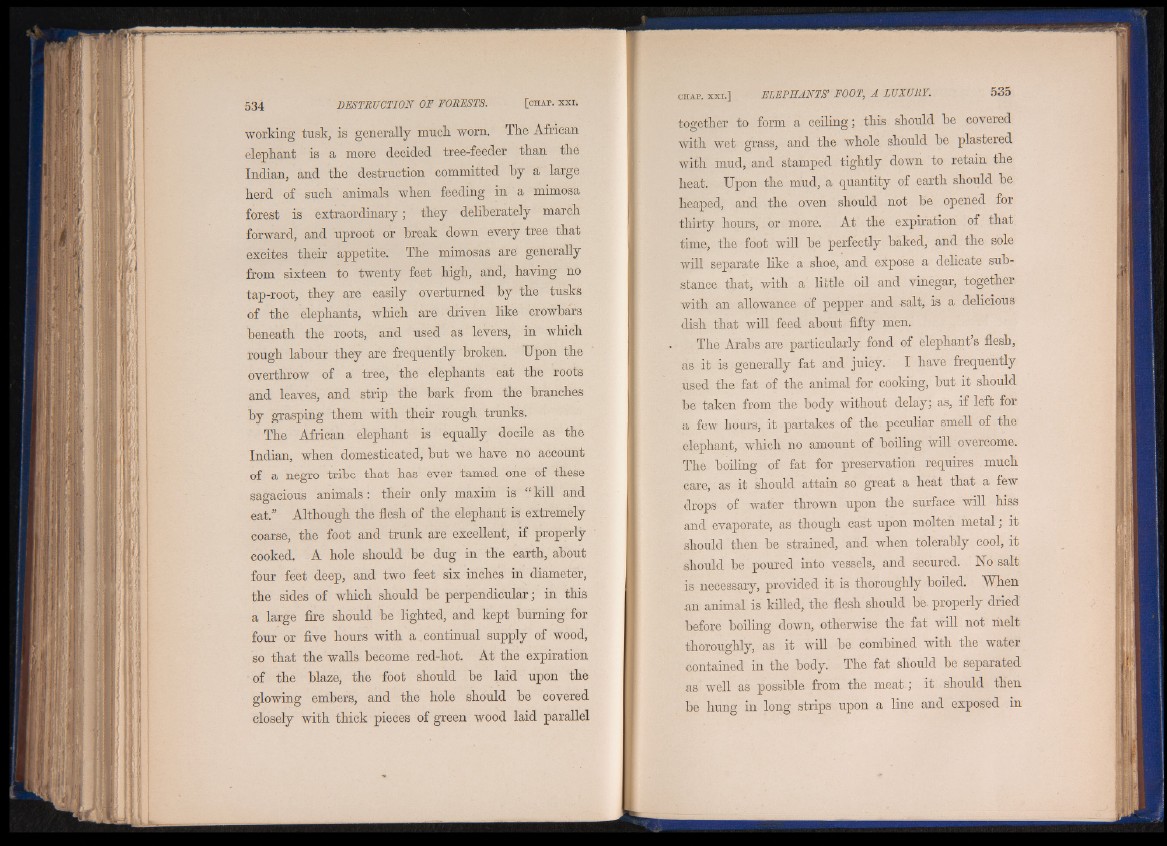
working tusk, is generally much worn. The African
elephant is a more decided tree-feeder than the
Indian, and the destruction committed by a large
herd of such animals when feeding in a mimosa
forest is extraordinary; they deliberately march
forward, and uproot or break down every tree that
excites their appetite. The mimosas are generally
from sixteen to twenty feet high, and, having no
tap-root, they are easily overturned by the tusks
of the elephants, which are driven like crowbars
beneath the roots, and used as levers, in which
rough labour they are frequently broken. Upon the
overthrow of a tree, the elephants eat the roots
and leaves, and strip the bark from the branches
by grasping them with their rough trunks.
The African elephant is equally docile as the
Indian, when domesticated, but we have no account
of a negro tribe that has ever tamed one of these
sagacious animals: their only maxim is “kill and
eat.” Although the flesh of the elephant is extremely
coarse, the foot and trunk are excellent, if properly
cooked. A hole should be dug in the earth, about
four feet deep, and two feet six inches in diameter,
the sides of which should be perpendicular; in this
a large fire should be lighted, and kept burning for
four or five hours with a .continual supply of wood,
so that the walls become red-hot. At the expiration
of the blaze, the foot should be laid upon the
glowing embers, and the hole should be covered
closely with thick pieces of green wood laid parallel
together to form a ceiling; this should be covered
with wet grass, and the whole should be plastered
with mud, and stamped tightly down to retain the
heat. Upon the mud, a quantity of earth should be
heaped, and the oven should not be opened for
thirty hours, or more. At the expiration of that
time, the foot will be perfectly baked, and the sole
will separate like a shoe, and expose a delicate substance
that, with a little oil and vinegar, together
with an allowance of pepper and salt, is a delicious
dish that will feed about fifty men.
The Arabs are particularly fond of elephant’s flesh,
as it is generally fat and juicy. I have frequently
used the fat of the animal for cooking, but it should
be taken from the body without delay; as, if left for
a few hours, it partakes of the peculiar smell of the
elephant, which no amount of boiling will overcome.
The boiling of fat for preservation requires much
care, as it should attain so great a heat that a few
drops of water thrown upon the surface will hiss
and evaporate, as though cast upon molten metal; it
should then be strained, and when tolerably cool, it
should be poured into vessels, and secured. Ho salt
is necessary, provided it is thoroughly boiled. When
an animal is killed, the flesh should be- properly dried
before boiling down, otherwise the fat will not melt
thoroughly, as it will be combined with the water
contained in the body. The fat should be separated
as well as possible from the meat; it should then
be hung in long strips upon a line and exposed in